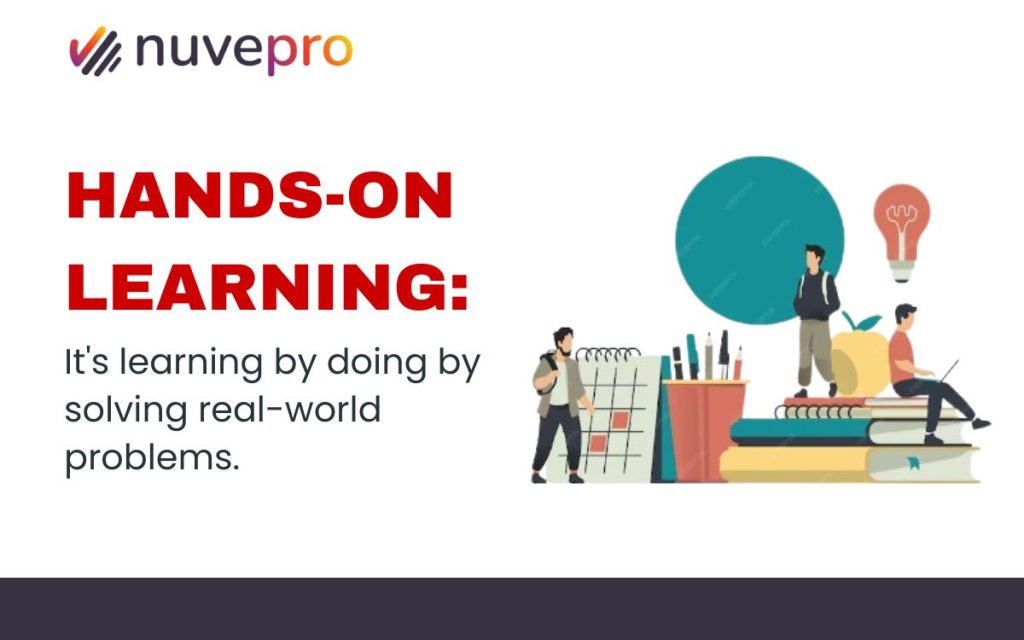What is Hands-on Learning?
It’s learning by doing by solving real-world problems.
Nuvepro talks about Hands-on learning.
In today’s fast-paced digital era, the demand for skilled IT professionals is at an all-time high. However, traditional educational models often struggle to keep pace with the rapid advancements in technology, leaving many professionals ill-prepared for the challenges of the modern workplace. This is where hands-on learning emerges as a game-changer, offering IT workforces a dynamic and immersive educational approach that bridges the gap between theory and practice. In this article, we delve into the transformative power of hands-on education, exploring its benefits, applications, and real-world impact on IT professionals.
Understanding Hands-On Learning
Hands-on learning, also known as experiential learning or learning-by-doing, is a pedagogical approach that emphasizes active engagement and practical experience.
Rather than passively absorbing information, learners are encouraged to actively participate in activities, projects, and real-world simulations. Hands-on learning epitomizes its name: it’s about acquiring new knowledge, skills, and abilities through experiencing it in a real-world.
According to a groundbreaking study by Morgan McCall, Robert W. Eichinger, and Michael M. Lombardo at the Centre for Creative Leadership, known as the 70:20:10 rule, the majority of learning—70%—emanates from real-life experiences, on-the-job tasks, and problem-solving. This aspect holds paramount significance in any comprehensive learning and development strategy. Additionally, the study highlights that 20% of learning is derived from feedback and interaction with role models, while a mere 10% originates from formal education settings.
The 70:20:10 rule underscores the importance of experiential learning in professional growth and development. By immersing individuals in real-life scenarios and challenges, organizations can cultivate practical skills, critical thinking abilities, and problem-solving acumen.
Why Hands-on learning?
Enhanced Engagement and Retention: Hands-on learning fosters increased engagement and knowledge retention among IT professionals. By actively participating in practical exercises and projects, individuals develop a deeper understanding of complex concepts and methodologies, leading to better retention of information.
Skill Development: Hands-on learning enables IT professionals to develop practical skills that are directly applicable to their roles. Whether it’s troubleshooting technical issues, deploying software solutions, or optimizing network infrastructure, hands-on experience provides invaluable practical insights and expertise.
Problem-Solving Abilities: One of the key benefits of hands-on learning is its ability to enhance problem-solving skills. By engaging in real-world scenarios and challenges, IT professionals learn to think critically, analyze problems, and develop innovative solutions—a crucial skillset in today’s technology-driven world.
From Certifications to hands-on learning:
The allure of certifications is undeniable—they look impressive on resumes and are often associated with career advancement and higher earning potential.
But here’s where the real magic happens beyond the pursuit of certificates lies a profound journey of hands-on learning and self-discovery. It’s easy to fall into the trap of racing through courses, checking off assignments, and collecting certificates like trophies. However, true learning goes beyond the acquisition of a badge; it’s about delving deep into a subject, questioning assumptions, and developing a genuine understanding.
Beyond the certificates, the depth of learning is what truly matters. It’s the knowledge and skills that you carry forward in your career and personal life. It’s the ability to think critically, solve complex problems, and adapt to new challenges. Employers value individuals who possess not just a certificate but a deep understanding of their field.
While certifications remain a valuable asset, the digital age has brought forth a paradigm shift. Employers today seek candidates who can not only showcase their theoretical knowledge but also demonstrate their ability to apply this knowledge in real-world scenarios. This transition from the “what” to the “how” has brought hands-on learning to the forefront.
In conclusion, hands-on learning represents a powerful tool for empowering IT workforces and driving organizational success in today’s digital age. By providing individuals with practical experience, skills development, and problem-solving abilities, hands-on education equips IT professionals with the tools they need to thrive in a rapidly evolving industry. As technology continues to advance, the importance of hands-on learning will only grow, making it essential for organizations to prioritize experiential education in their training and development initiatives.
References:
Smith, J. (2022). The 70:20:10 Model: Explained & Defined for Training & Development. Retrieved from [link]
Johnson, M. (2023). The Impact of Experiential Learning on IT Professionals: A Case Study Analysis. Journal of Information Technology Education, 15(2), 45-62.




